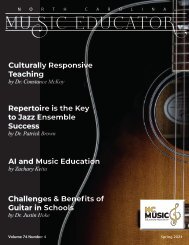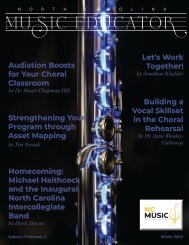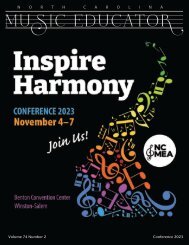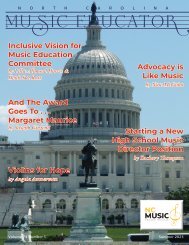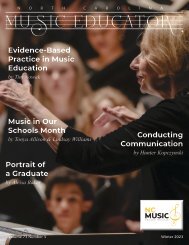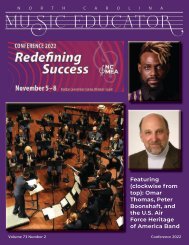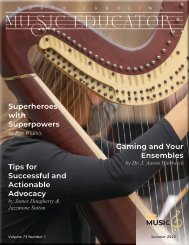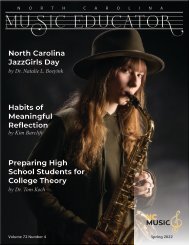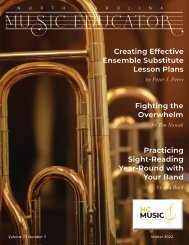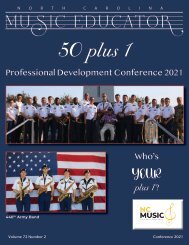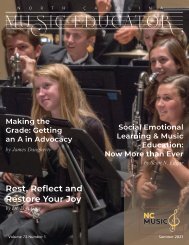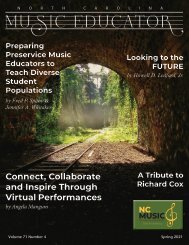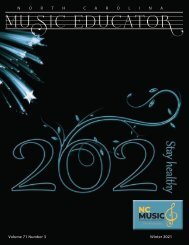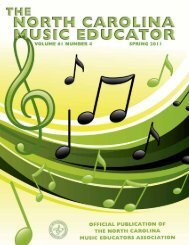NC Music Educator Winter 2017
North Carolina Music Educators Association Journal Winter 2017
North Carolina Music Educators Association Journal Winter 2017
- No tags were found...
You also want an ePaper? Increase the reach of your titles
YUMPU automatically turns print PDFs into web optimized ePapers that Google loves.
provise, it is fun to also sing folk songs with a swing or gospel<br />
style. Try singing the West African Yoruba song, “Funwa<br />
Alafia” in the style of Wagner and encourage the singers to add<br />
their own full, rich harmony. Be sure to encourage a soprano<br />
and tenor to sing the high note on the final chord!<br />
“Funwa Alafia” has a limited range and is quickly learned.<br />
Singers can experiment with bright and dark tone qualities,<br />
forward placement, swallowed placement, etc. Once singers<br />
can produce a variety of supported choral tones they can then<br />
transfer that technique to other literature they’re learning. For<br />
example, young adolescents may sing a Mozart octavo with<br />
a heavy tone quality. After experimenting with tone qualities<br />
and bright and dark placements, the teacher can remind them<br />
to adjust their tone accordingly because it is now part of their<br />
vocal production vocabulary.<br />
Possibilities are endless when we use music from the rich<br />
array of folk music across the globe. Our students’ success is<br />
limited only by our imagination. For example, ask students to:<br />
• Sing a folk song and clap on all of the eighth notes.<br />
• Sing a folk song on a neutral pitch. Sing only the pitches<br />
A and F – audiate the other pitches of the song.<br />
• Lip sync a song and only sing the last word in each<br />
phrase.<br />
• Sing a folk song as a canon. Part one sings the original<br />
language and the second part sings the English translation.<br />
Each of the folk songs mentioned in this article, and additional<br />
strategies for using world music in choral ensembles<br />
can be found in the book, Wander the World with Warm-Ups,<br />
published by Shawnee Press.<br />
In closing, consider including world music and folk songs<br />
from our own rich heritage here in the United States to supplement<br />
warm-ups in choral rehearsals. They provide tools<br />
creating a variety for the singers and allow them an opportunity<br />
to explore music concepts in warm-ups that can later be<br />
transferred to the students’ performance literature. Thank you<br />
for caring about students and for sharing your music!<br />
Dr. Lynn M. Brinckmeyer is professor of music, associate director<br />
for the school of music and director of choral music education<br />
at Texas State University. During 2006 – 2008 she served as president<br />
of NAfME. She recently published, Wander the World with<br />
Warm-ups, and Advocate for <strong>Music</strong> with Oxford University.<br />
18 | NORTH CAROLINA MUSIC EDUCATOR




